West Implements Oil Price Cap on Russia but Analysts say Russia Can Skirt Impacts

China pivots on zero-Covid policy
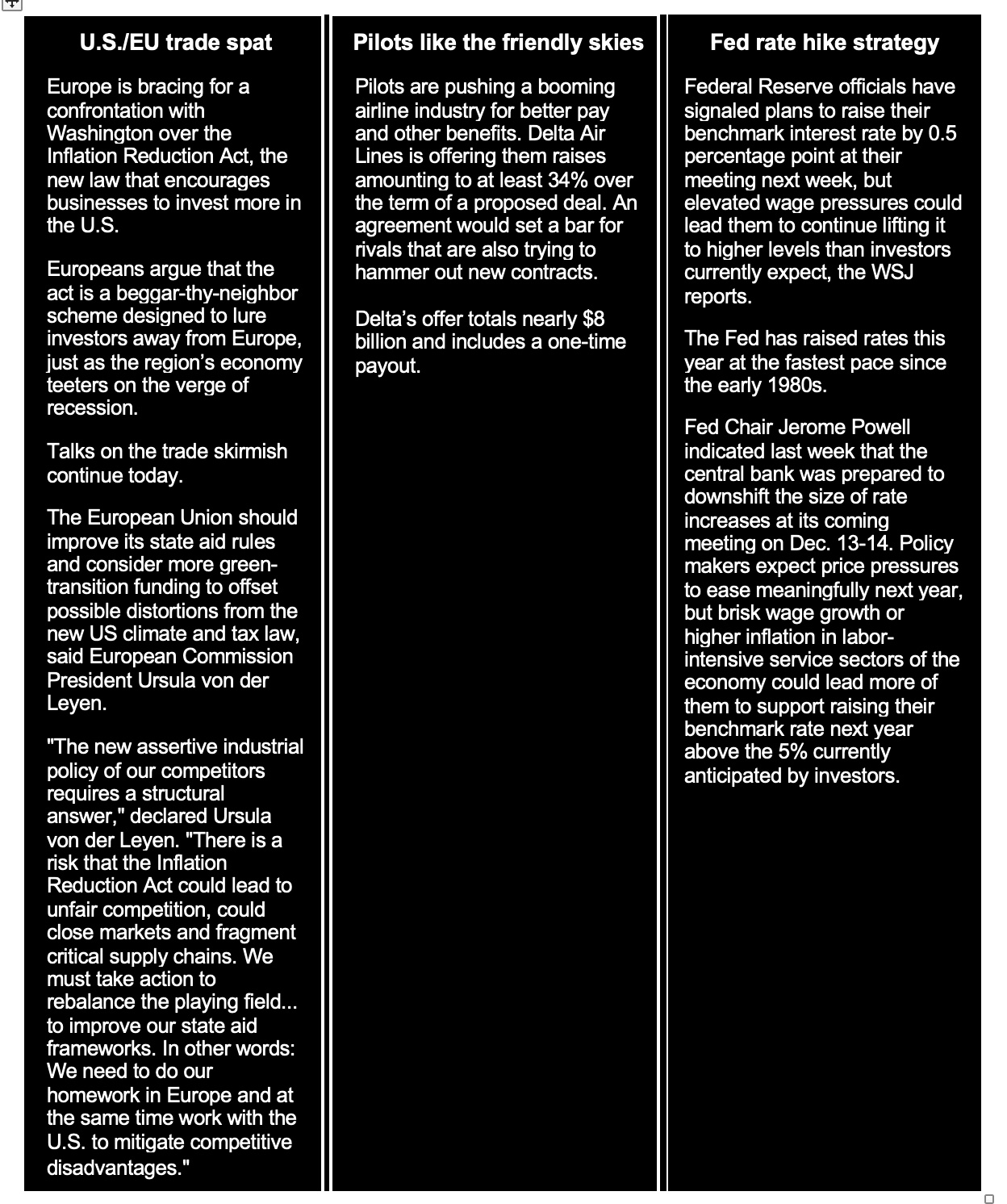
|
In Today’s Digital Newspaper |
China pivots on zero-Covid. Chinese authorities eased Covid testing requirements across major cities over the weekend. The financial hub of Shanghai scrapped PCR testing requirements to enter outdoor public venues such as parks or use public transportation starting Monday. Hangzhou, home to tech giant Alibaba Group Holding Ltd., dropped obligations to enter most public venues including offices and supermarkets. Chinese stocks rallied, while the yuan strengthened past the key 7-per-dollar level as a result. Morgan Stanley analysts upgraded its rating for Chinese equities, saying a “path towards reopening is finally set, likely bumpy but with no turning back.”
Apple has accelerated plans in recent weeks to shift some production outside China, with steps that would likely bring along scores of the suppliers within the complicated network behind the company’s iPhones, tablets and other high-value electronics.
OPEC+ kept its oil curbs despite the Russia price cap. OPEC+ agreed to stick to its oil output targets two days after the Group of Seven nations agreed to a price cap on Russian oil, delegates said. We have details on both actions, below.
Crude oil impacts: WTI crude futures traded above $80 early Monday morning, while Brent crude eclipsed $86. Oil prices also got some support from OPEC+, which said it would stick with its plan to cut production, even as the G7 slapped a $60-a-barrel price cap on Russian oil. “It is the right decision to hold steady, especially if you don’t know how much, if at all, Russian production is going to fall after today,” Amrita Sen, head of research at energy consultancy Energy Aspects, told CNBC. Meanwhile, Biden administration officials are trying to reassure oil market participants that the newly agreed $60 price cap on Russian crude won’t trigger supply disruptions and price volatility after it kicks in Monday.
Credit Suisse stock surged Monday after a report that Saudi Crown Prince Mohammed bin Salman and a U.S. private-equity firm are considering investing in the Swiss lender’s investment bank spinoff.
Apple has accelerated plans to shift some of its production outside China, long the dominant country in the supply chain that built the world’s most valuable company. It is telling suppliers to plan more actively for assembling Apple products elsewhere in Asia, particularly India and Vietnam. Details in China section.
Why did EPA not use the most up-to-date info on renewable diesel capacity when making its RFS announcements last week? See Energy section.
Some Ukrainian wheat was unharvested, according to satellite info. Meanwhile, Ukraine’s wheat exports slowed in November.
What has Iowa Democrats so upset? See the Politics & Elections section for answer.
|
MARKET FOCUS |
Equities today: Chinese stock indexes, oil prices and the yuan got a boost as officials loosened zero-Covid policies. Global stock markets were mostly weaker overnight. U.S. stock indexes are pointed toward slightly lower openings. In Asia, Japan +1.8%. Hong Kong +4.5%. China +1.8%. India -0.1%. In Europe, at midday, London +0.3%. Paris -0.4%. Frankfurt -0.5%.
U.S. equities Friday: The Dow managed to finish in positive territory after the surprisingly strong jobs update while both the Nasdaq and S&P 500 finished lower. But all three registered gains for the week, with the Dow up 0.2%, the Nasdaq up 2.1% and S&P 500 gained 1.1%. On Friday, the Dow rose 34.87 points, 0.10%, at 34,429.88. The Nasdaq was down 20.95 points, 0.18%, at 11,461.50. The S&P 500 eased 4.87 points, 0.12%, at 4,071.70.
Hopes that inflation is easing have driven a weekslong rally in government bonds, pulling the 10-year U.S. Treasury yield back to 3.5% for the first time since September.
Credit Suisse (CS) shares rose more than 7% after the Wall Street Journal reported that Saudi Arabia’s Crown Prince Mohammed bin Salman is preparing to invest in the lender’s investment bank. Prince Mohammed may invest around $500 million in the lender’s CS First Boston spinout, the newspaper said, citing people with knowledge of the matter. Other investors could include former Barclays chief executive Bob Diamond’s Atlas Merchant Capital, according to the report.
Agriculture markets Friday:
- Corn: March corn fell 14 1/4 cents to $6.46 1/4, down 25 cents for the week and the lowest close since Aug. 22.
- Soy complex: January soybeans rose 8 3/4 cents to $14.38 1/2, up 2 1/4 cents on the week. January soymeal rose $2.50 to $424.10, up $17.80 for the week and the contract’s highest close since Sept. 21. January soyoil fell 216 points to 65.22 cents, the lowest since Oct. 17.
- Wheat: March SRW wheat dropped 22 cents to $7.61, down 36 cents for the week and the contract’s lowest close since Jan. 14. March HRW wheat fell 19 1/2 cents to $8.70 3/4, down 41 1/4 cents for the week and a three-month low. March spring wheat fell 16 3/4 cents to $9.21 1/4.
- Cotton: March cotton fell 165 points to 83.20 cents, still up 302 points for the week.
- Cattle: February live cattle futures rose 45 cents to $155.875, up 75 cents for the week. January feeder cattle jumped $1.375 to $182.45, up $4.15 for the week.
- Hogs: February lean hog futures surged $1.225 to $90.425, up. $1.925 for the week and the contract’s highest close since Nov. 17.
Ag markets today: Soybeans and wheat were mildly firmer in overnight trade, while corn traded narrowly on either side of unchanged. As of 7:30 a.m. ET, corn futures were trading steady to fractionally higher, soybeans were 3 to 6 cents higher and wheat futures were 1 to 2 cents higher. Front-month crude oil futures were more than $2 higher and the U.S. dollar index was nearly 150 points lower.
Technical viewpoints from Jim Wyckoff:
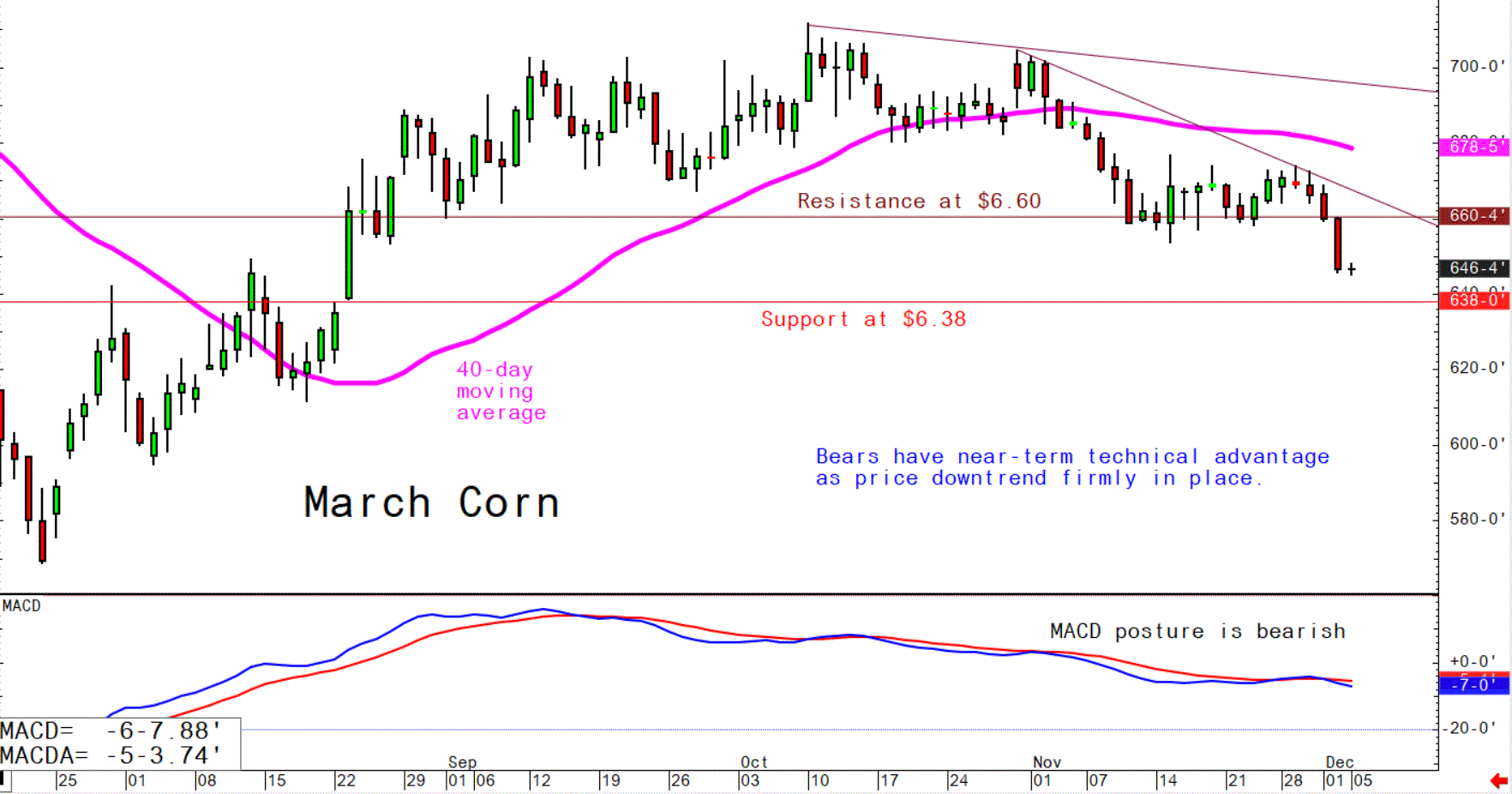
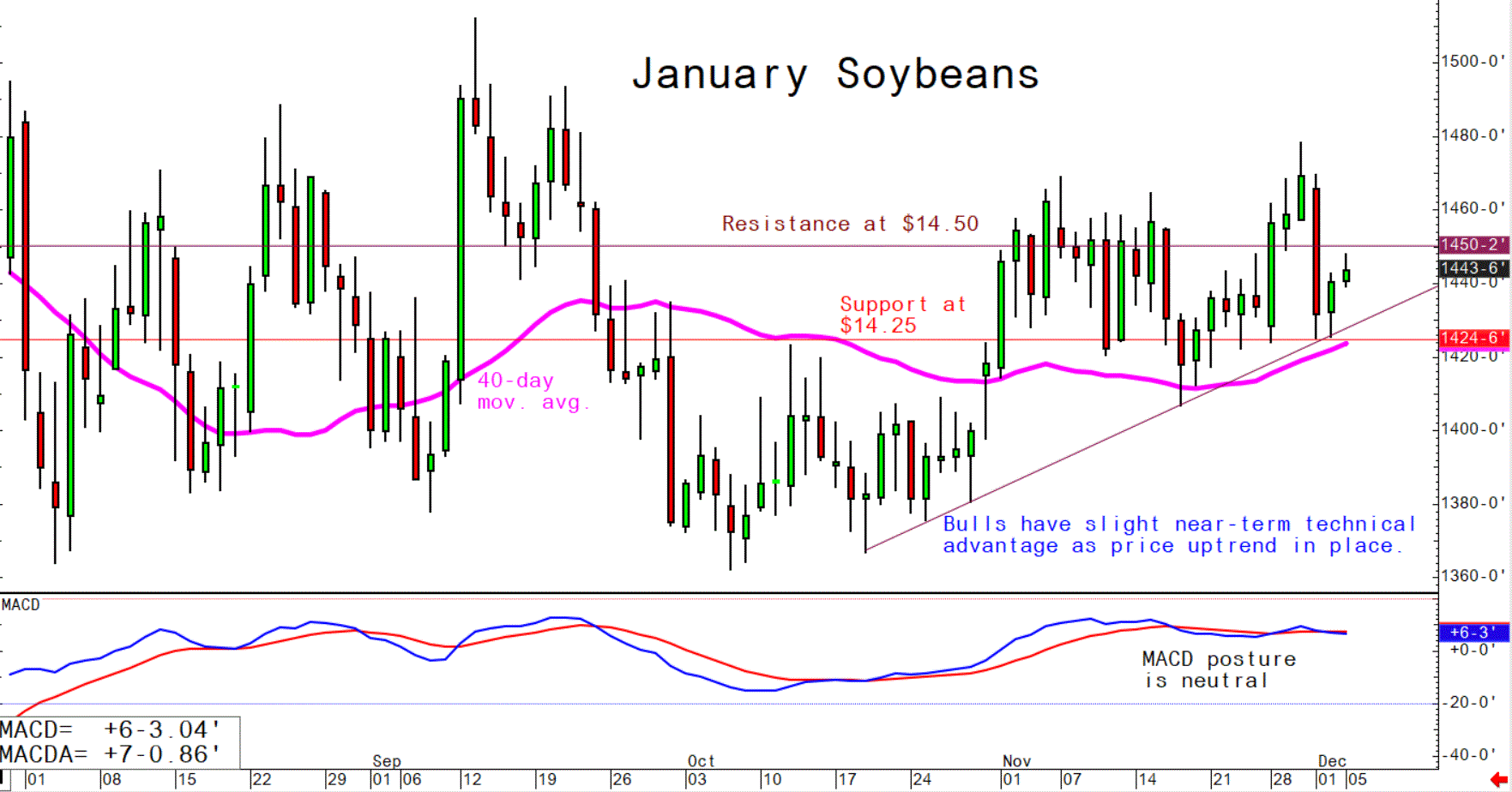
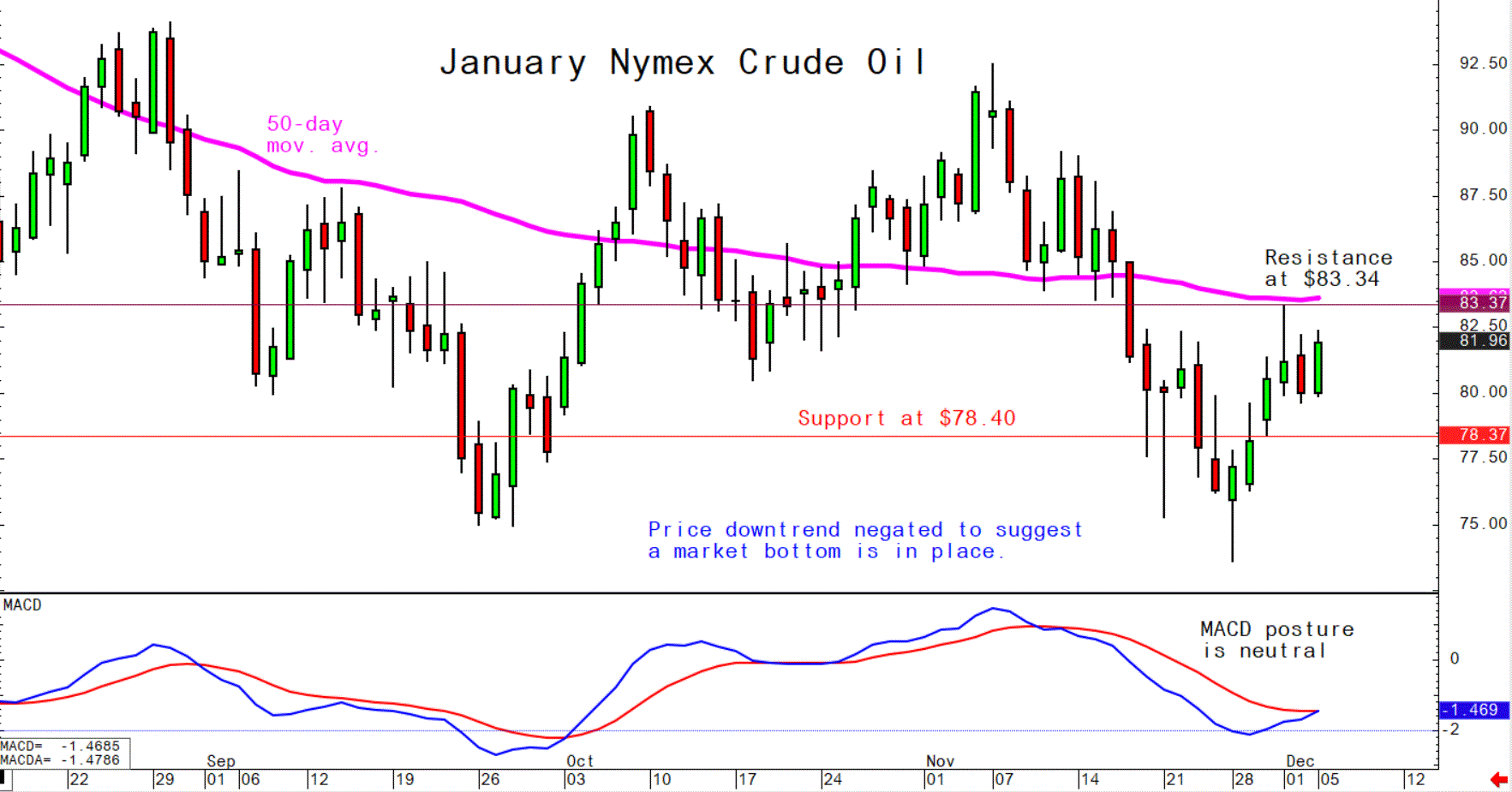
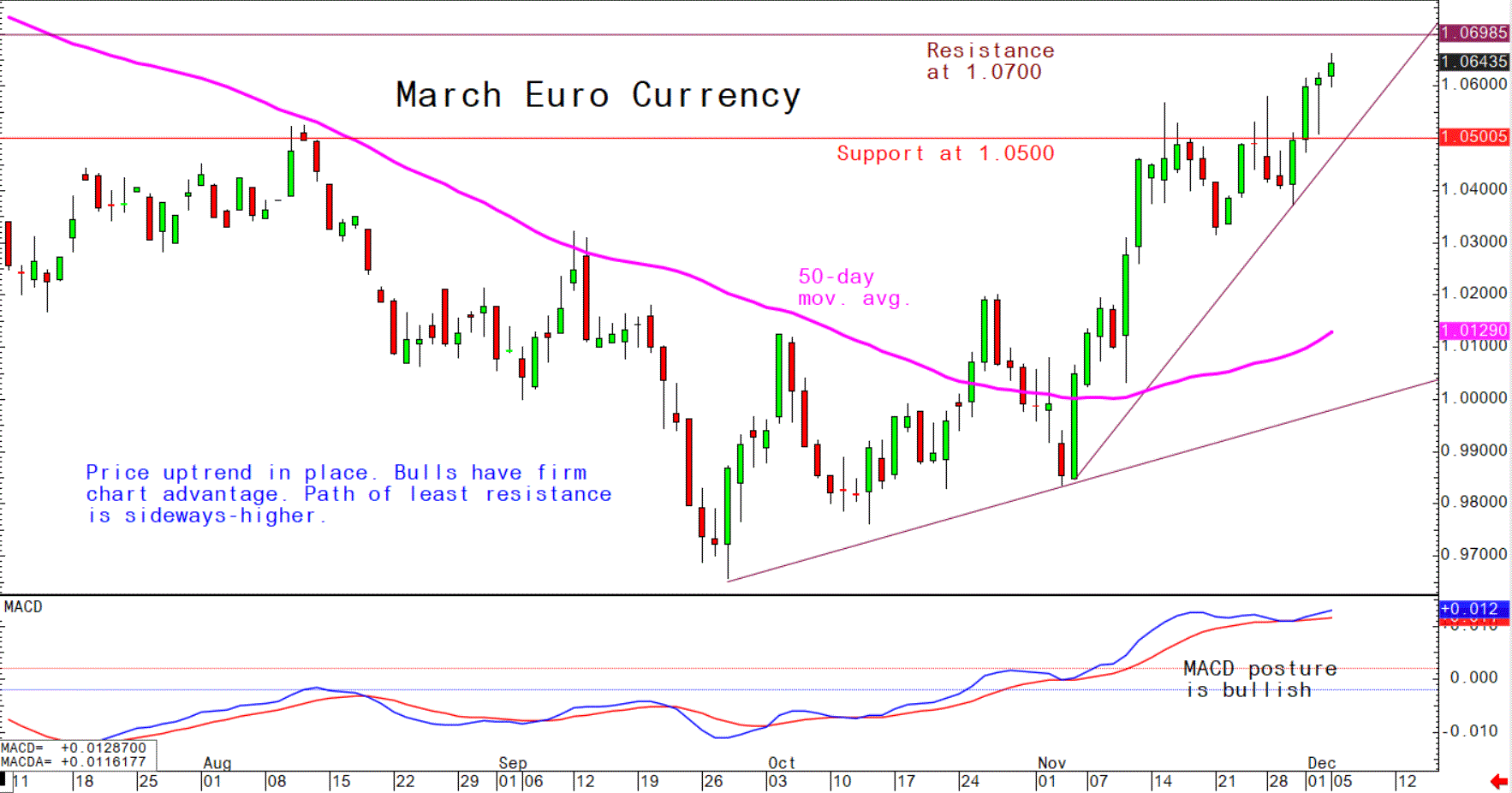
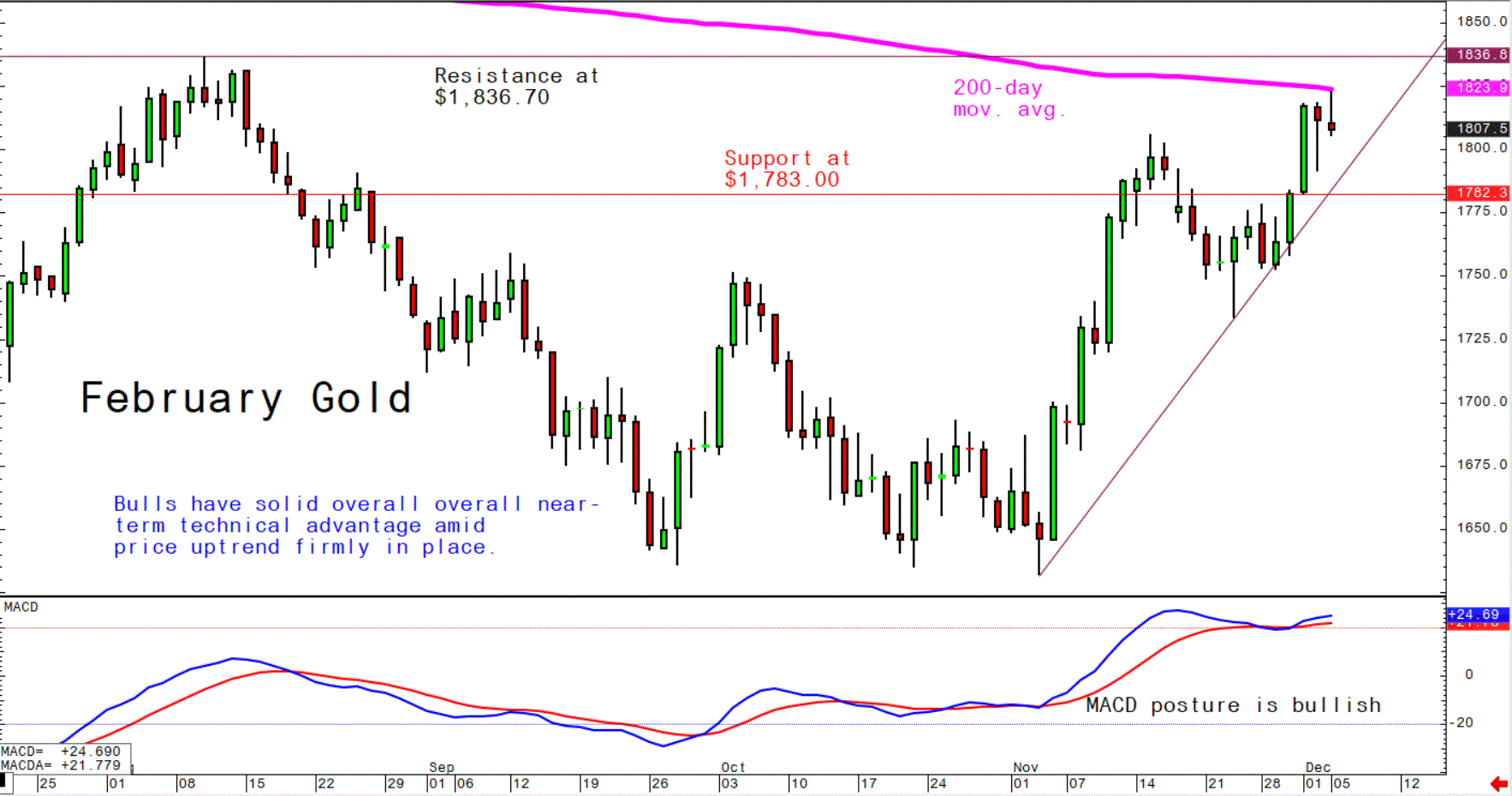
On tap today:
• S&P Global's U.S. services index for November, due at 9:45 a.m. ET, is expected to tick up to 46.2 from a preliminary reading of 46.1.
• Institute for Supply Management's services index, due at 10 a.m. ET, is expected to fall to 53.7 in November from 54.4 one month earlier.
• U.S. factory orders for October, due at 10 a.m. ET, are expected to increase 0.7% from the prior month.
• USDA Grain Export Inspections report, 11 a.m. ET.
• WSJ CEO Council Summit begins in Washington, D.C. Monday's speakers include Secretary of State Antony Blinken, White House Chief of Staff Ron Klain and Sen. Tom Cotton.
The European Union’s statistics agency Monday reported a 1.8% drop in retail sales during October from the prior month, the largest fall since July 2021.
Latest evidence of continuing wage pressures: Friday’s November jobs report showed annual growth in hourly earnings accelerating to 5.1% from 4.9% in October. Workers continue to win significant pay bumps, in part because help remains hard to find.
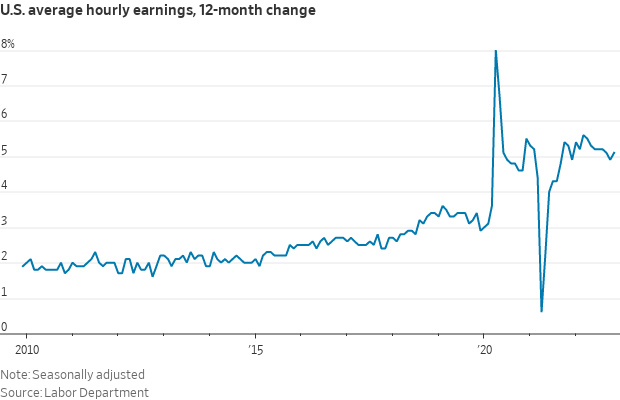
The regular WSJ survey finds economists think there is a 63% chance of recession in the next year. And a survey of economists and investors by the Federal Reserve Bank of Philadelphia shows expectations that gross domestic product will fall in three or four quarters are by far the highest since it started in 1968. But just because economists are convinced of their predictions doesn’t mean they are right. Since that Philly Fed survey started, not a single recession was spotted a year in advance. Economists missed the 1990, 2001 and 2008 recessions completely.
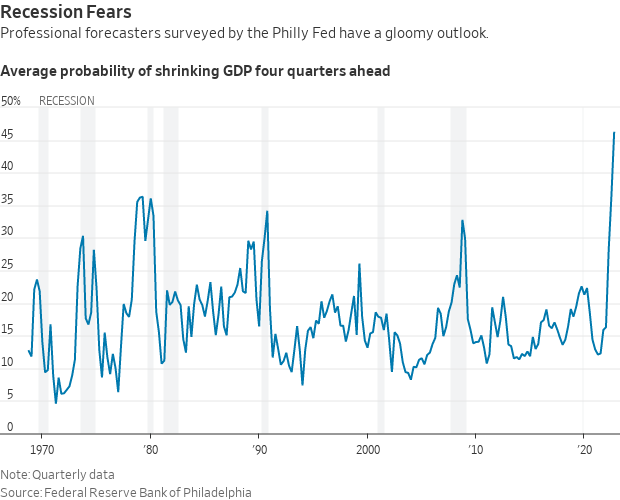
Market perspectives:
• Outside markets: The U.S. dollar index was weaker with the euro and yen both firmer against the greenback. The yield on the 10-year US Treasury note was firmer, trading around 3.52%, while global government bond yields were mixed to mostly lower. Crude is higher, with U.S. crude around $81.90 per barrel and Brent around $87.70 per barrel in the wake of the deal to cap Russian oil prices. Gold and silver futures were under mild pressure, with gold around $1,807 per troy ounce and silver around $21.19 per troy ounce.
• Argentine crop stress to continue, mostly favorable conditions in Brazil. Argentina’s weather will remain stressful for crops this week amid limited rain and warm to hot temperatures, according to World Weather Inc. The forecaster says Brazil’s weather will be generally favorable, with weekend rains forecast to continue early this week. But some areas in the center-west and south-central parts of the country could be missed by the greatest rainfall.
• Ag trade: Pakistan purchased 450,000 MT of Russian wheat.
• NWS weather: Heavy rain and the risk for scattered flash flooding developing over the Tennessee Valley... ...Snow across the central Rockies, parts of the northern Rockies, and extending east into the northern Plains... ...Showers will expand northeast toward New England on Tuesday ahead of a cold front as rain becomes more focused near the trailing portion of the front across the southern Plains.
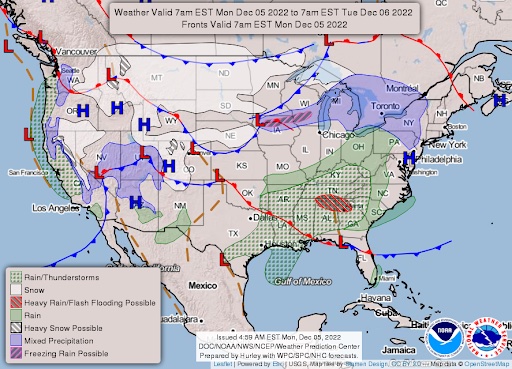
Items in Pro Farmer's First Thing Today include:
• Mostly firmer tone to start the week
• Brazilian soybean, first corn planting about complete
• China again sells all wheat put up for auction
• Choice beef under $250
• Cash hog index continues to weaken
|
RUSSIA/UKRAINE |
— Summary: Western restrictions on the Russian oil industry kicked in. The moves aim to crimp Russia’s oil income while preventing a surge in energy prices.
- The West imposed sanctions on Russian crude, putting the conflict with Moscow into an unpredictable new phase that could inject further volatility into global oil markets. The European Union and U.K. barred inbound shipments of Russian crude Monday. In tandem, the EU, the U.S. and allies placed curbs on shipping, insuring and funding Russian crude anywhere in the world. The restrictions are the first major attempt to curb Moscow’s fossil-fuel revenue, which steadied the Russian economy after a barrage of sanctions on other industries. But there is a deliberate loophole, enabling companies to facilitate Russian oil shipments to countries outside of Europe if the price is no higher than $60 a barrel. An adjustment mechanism keeps the cap at least 5% below the market rate and allows for revisions every two months.
How it works: The deal allows Russian oil to be shipped to third-party countries using G7 and EU tankers, only if the cargo is bought at or below the $60 per barrel cap. The level is seen as high enough to cover production costs and encourage more output, though Ukraine's Volodymyr Zelenskyy slammed the agreement, calling it "quite comfortable for the budget of a terrorist state." G7 insurance companies, credit institutions and transport services will also have to observe the price ceiling, which is important as 95% of the world's oil tanker fleet is covered by the International Group of P&I Clubs in London and companies based in continental Europe.
Moscow said this weekend that it wouldn’t accept the Western price cap, and that it would cut sales to countries that participate in the arrangement. How much of an effect that will have is unclear: Even before today, European countries have systematically reduced their Russian crude purchases since the start of the war in Ukraine — only for China to step in and buy more oil, often at a discount. But in recent weeks, China has paused some purchases as it waited for details of the price cap to be announced. A Russian presidential decree would also prohibit loadings destined for any countries that adopt the restrictions, and ban any reference to a price cap in contracts for Russian crude or oil products. "We are working on mechanisms to prohibit the use of a price cap instrument, regardless of what level is set, because such interference could further destabilize the market," said Russian Deputy Prime Minister Alexander Novak.
Bottom line: Many analysts still say that Russia has enough of a shadow fleet to skirt the sanctions, meaning more shipments will be rerouted, which is already happening across global crude markets.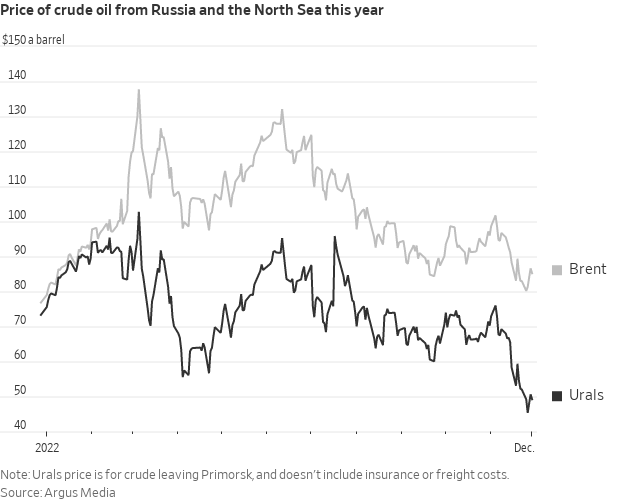
- What’s the Russian economy look like? “It’s like a cake that was dropped on the table and it looks more or less fine, but inside it’s all blown up.” — Vladislav Inozemtsev, the Washington-based director of the Center for Post-Industrial Studies, a Russian research group, on the state of the Russian economy following sanctions and an exodus of Western firms.
- Two Russian bombers were the apparent targets of an attack on an air base near Ryazan, southeast of Moscow. Reports indicated drone attacks were behind the explosions. The base has reportedly served as the launch site for airstrikes on Ukraine over the past few weeks. While Ukraine has made advances on the battlefield, Russian missiles have crippled much of the country’s infrastructure, plunging millions into darkness as bitterly cold weather settles into the region.
- Ukraine’s wheat exports slow in November. Ukraine’s wheat exports fell to 1.58 MMT in November from 1.98 MMT in October, the UGA Ukrainian grain traders union said on Monday. UGA said Ukrainian exporters had declared 5 MMT of grains and oilseeds for export during November and the “grain corridor” contributed 2.3 MMT last month, down more than 1.2 MMT from October. Since July 1, Ukraine has exported 18.3 MMT of grain, down nearly 30% from the same period last year, according to the country’s ag ministry. That included 9.8 MMT of corn, 6.9 MMT of wheat and 1.5 MMT of barley.
- Ukraine has lost at least $1 billion of wheat that was harvested in areas controlled by Russia, according to research using satellite imagery from NASA’s food security and agriculture program. The analysis gives an idea of what’s happening in occupied territories, where information is tightly controlled. It uses a machine-learning model detecting texture and color changes based on a time-series of satellite images to map where crops have been harvested or left unharvested. Almost 6 million tons of wheat was collected from areas not under Ukrainian control, according to NASA Harvest. About 88% of the winter crops planted in occupied areas were harvested, while unharvested areas were mainly along the front line. Link for details.
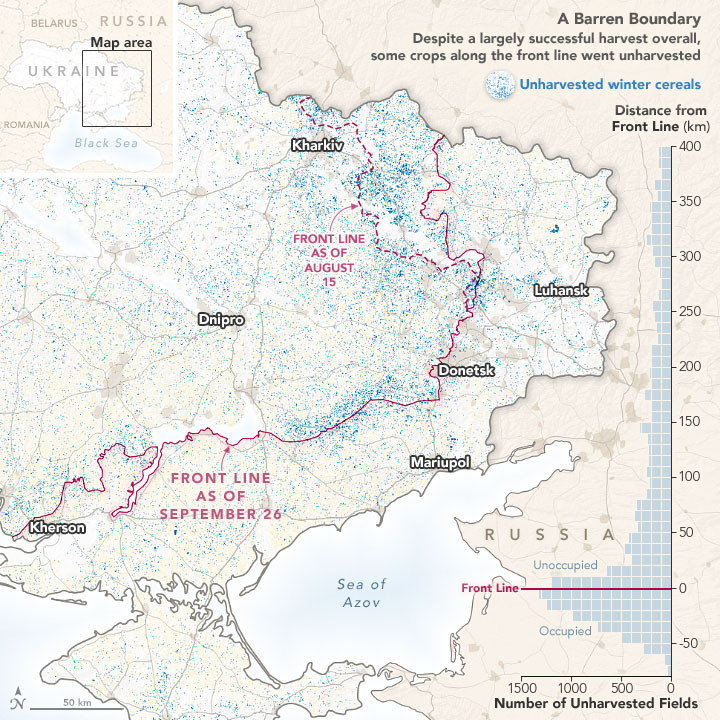
|
CHINA UPDATE |
— Chinese officials continue scaling back some of the strictest Covid restrictions. Latest: Major cities, including Shenzhen and Beijing, announced they will no longer require a negative Covid test for residents to ride on public transportation.
Meanwhile, one of the most frequent complaint Chinese make about being locked down while other countries are not: All the crows they see watching World Soccer Cup games. Some 530 million people — almost 40 % of the population — were under some form of lockdown in late November, according to one estimate.
— Apple accelerates plans to move iPhone production beyond China. Apple is speeding up plans to move some of its gadget production out of China to places in India and Vietnam to reduce its reliance on Foxconn Technology and other Taiwanese assemblers, the Wall Street Journal reported. Protests over wages and Covid-19 lockdowns at a place known as iPhone City in Zhengzhou, China, built momentum for the shift, the report said. As many as 300,000 workers at a Foxconn factory made up to 85% of the iPhone Pro lineup, the WSJ reported, citing Counterpoint Research. Various Chinese cities relaxed restrictions over the weekend. Wedbush analyst Dan Ives said in a report on Sunday that disruptions at the plants have cost Apple’s production of its highest-end iPhones going into the holidays. Moving production to India and Vietnam will come with logistical, engineering, and infrastructure challenges, he added. If Apple moves aggressively, more than half of iPhone production could come out of India and Vietnam by 2025-2026, Ives said, adding Apple has no choice but to make these painful moves now.

|
ENERGY & CLIMATE CHANGE |
— OPEC keeps oil output steady as Russian cap begins. The Organization of the Petroleum Exporting Countries and Russia-led allies known as OPEC+ will keep output steady, but will cut it by two million barrels a day, as agreed in October. This comes as the Group of Seven’s $60-a-barrel price cap on Russian oil kicks in today and the European Union bans most imports of Russian oil, as noted previously.
Time to weigh market impact. Keeping the production cut the same as what the alliance decided in October, which OPEC calls a “rollover,” gives OPEC+ time to weigh the market impact of the price cap, the Wall Street Journal reported. U.S. retail gas prices have dropped to $3.36 a gallon at the pump.
Oil prices have plunged from more than $130 a barrel in March, after Russia invaded Ukraine on Feb. 24, and dropped 13% last month. Brent Crude, the international benchmark, and West Texas Intermediate, the U.S. benchmark, are both trading below $90 a barrel.
Background. The U.S. and its allies designed the cap to reduce Russia’s oil revenue while allowing Russian oil to keep flowing. Russia was producing 9.9 million barrels a day in October, and the International Energy Agency expects that to drop by 1.4 million barrels a day, the WSJ reported.
Now what? OPEC could still increase production in early 2023. Although OPEC+ isn’t scheduled to review production until its June 4 meeting, the alliance is prepared to meet at any time and take immediate additional measures to address market developments if needed, the WSJ reported.
— Why did EPA use old data on renewable diesel ahead of RFS announcement? Renewable diesel capacity topped 2 billion gallons per year as of August, according to the latest data released from the U.S. Energy Information Administration (EIA). But EPA used a lower figure, 1.5 billion gallons per year, based on the EIA info as of February. “Domestic renewable diesel production capacity has increased significantly in recent years from approximately 280 million gallons in 2017 to nearly 1.5 billion gallons in February 2022,” EPA said Thursday. A footnote said: "February 2022 renewable capacity based on EIA Monthly Biofuels Feedstock and Capacity Update."
Meanwhile, private analysts note that a Valero plant is starting up six months early and they quote 2 billion gallons in capacity.
Pressure is already on EPA to modify its renewable diesel decisions and that could happen in a final rule, some contacts note. EPA has until June 14, 2023, to issue a final rule. And most expect the relative short comment period deadline of Feb. 10 to be extended.
But note this: EPA has typically not changed the proposed levels a great deal in their final versions over the years so a major shift higher in the advanced biofuel tally would come as a surprise.
|
HEALTH UPDATE |
— Summary:
- Global Covid-19 cases at 645,367,763 with 6,641,337 deaths.
- U.S. case count is at 645,367,763 with 6,641,337 deaths.
- Johns Hopkins University Coronavirus Resource Center says there have been 655,280,140 doses administered, 267,346,533 have received at least one vaccine, or 81.14% of the U.S. population.
|
POLITICS & ELECTIONS |
— Democrats put South Carolina first in primaries, dump Iowa. Democrats voted Friday to move the South Carolina primary to the front of their presidential nominating calendar, displacing Iowa in a bid to involve more minority voters and move away from caucuses that some say disadvantage working-class voters. South Carolina would be followed by New Hampshire and Nevada a week later. Georgia is fourth and Michigan would be fifth. The move comes after James Clyburn (D-S.C.), the No. 3 House Democrat credited with boosting Biden’s 2020 campaign, said the president called him to say he was recommending that South Carolina replace Iowa. The Republicans will not make a similar move.
The Iowa Democratic Party has already threatened to hold the caucuses without regarding the DNC's new calendar. If so, the DNC could punish Iowa by taking away half its delegates. But Iowa doesn't have that many delegates.
“Democrats have really given middle America the middle finger,” said Sen. Joni Ernst (R-Iowa), responding to a question on Fox News Sunday about the Democrats’ move.
|
CONGRESS |
— Democrat Jeffries defends calling Trump ‘illegitimate’ president. Newly elected House Democratic leader Hakeem Jeffries (D-N.Y.) defended past remarks calling Donald Trump’s 2016 election “illegitimate” against Republican criticism, noting that he voted to certify his presidency.
|
KEY LINKS |
WASDE | Crop Production | USDA weekly reports | Crop Progress | Food prices | Farm income | Export Sales weekly | ERP dashboard | California phase-out of gas-powered vehicles | RFS | IRA: Biofuels | IRA: Ag | Student loan forgiveness | Russia/Ukraine war, lessons learned | Election predictions: Split-ticket | Congress to-do list | SCOTUS on WOTUS | SCOTUS on Prop 12 | New farm bill primer | China outlook |







